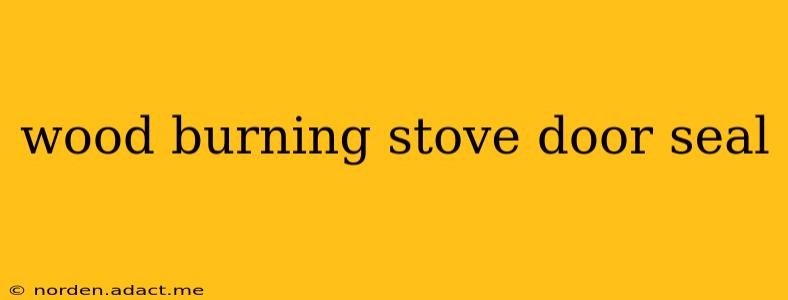A properly sealed wood burning stove door is crucial for efficient combustion, optimal heat output, and overall safety. A faulty seal can lead to smoke leakage, heat loss, and even dangerous carbon monoxide buildup. This comprehensive guide will explore everything you need to know about wood burning stove door seals, from identifying problems to performing repairs and replacements.
Why is my wood burning stove door seal leaking?
Several factors can contribute to a leaking wood burning stove door seal. The most common culprits include:
- Age and Wear: Over time, the seal material degrades, becoming brittle, cracked, or compressed, losing its ability to create an airtight seal. This is especially true for older stoves or those used frequently.
- High Heat: The intense heat generated by a wood burning stove can damage the seal material, causing it to warp, shrink, or melt.
- Improper Installation: If the door seal wasn't installed correctly initially, it may not be providing an adequate seal.
- Door Misalignment: If the stove door isn't properly aligned in its frame, it can prevent the seal from making proper contact.
- Physical Damage: Accidental bumps or impacts to the door or frame can damage the seal.
How do I know if my wood burning stove door seal needs replacing?
Several telltale signs indicate a problem with your stove door seal:
- Smoke Leakage: Smoke escaping from around the door is a clear indication of a faulty seal.
- Heat Loss: If you notice significant heat loss from around the door, it's likely the seal isn't doing its job.
- Creaking or Rattling Sounds: These noises can suggest the seal is loose, damaged, or worn.
- Visible Damage: Inspect the seal for cracks, splits, or other visible signs of wear and tear.
How do I replace a wood burning stove door seal?
Replacing a wood burning stove door seal is a relatively straightforward process, but it's essential to follow the correct steps. Always consult your stove's manual for specific instructions and safety precautions. Generally, the process involves:
- Removing the old seal: Carefully remove the old seal using a putty knife or similar tool.
- Cleaning the door and frame: Thoroughly clean the surfaces where the new seal will be installed to ensure proper adhesion.
- Installing the new seal: Apply the new seal according to the manufacturer's instructions. This usually involves pressing it firmly into the groove or applying adhesive.
- Testing the seal: Once installed, test the seal by operating the stove and checking for smoke leakage or heat loss.
What type of wood burning stove door seal is best?
Several types of seals are available for wood burning stoves, including rope seals, ceramic fiber rope, and high-temperature silicone gaskets. The best choice will depend on your stove's design and your specific needs. Consult your stove's manual or a qualified professional for recommendations.
How much does it cost to replace a wood burning stove door seal?
The cost of replacing a wood burning stove door seal varies depending on the type of seal, the size of the door, and the labor involved. You can typically purchase replacement seals for a relatively low cost, but professional installation might add to the overall expense.
Can I repair a damaged wood burning stove door seal instead of replacing it?
In some cases, minor damage to the seal may be repairable. However, if the damage is significant or the seal is old and brittle, replacement is usually the best option. Attempting a repair that fails could lead to continued leakage and safety hazards.
How often should I replace my wood burning stove door seal?
The lifespan of a wood burning stove door seal varies depending on usage frequency and the quality of the seal. However, it's generally recommended to inspect the seal annually and replace it every few years, or sooner if signs of damage or leakage appear. Regular inspection will ensure optimal performance and safety.
This guide provides a comprehensive overview of wood burning stove door seals. Remember to consult your stove's manual and, if needed, seek professional assistance for any repairs or replacements. Prioritizing a properly sealed stove ensures safety, efficiency, and the enjoyment of your wood-burning experience.
